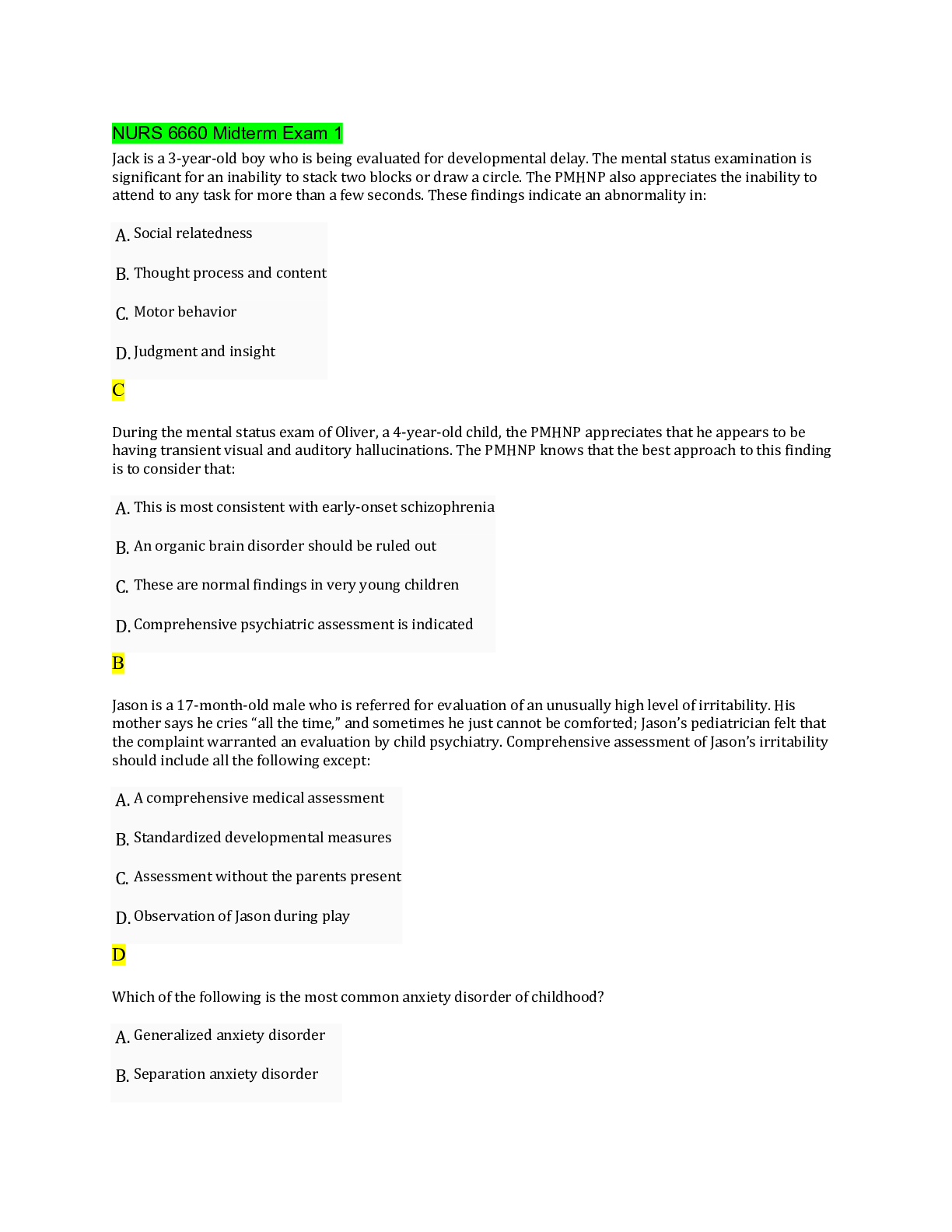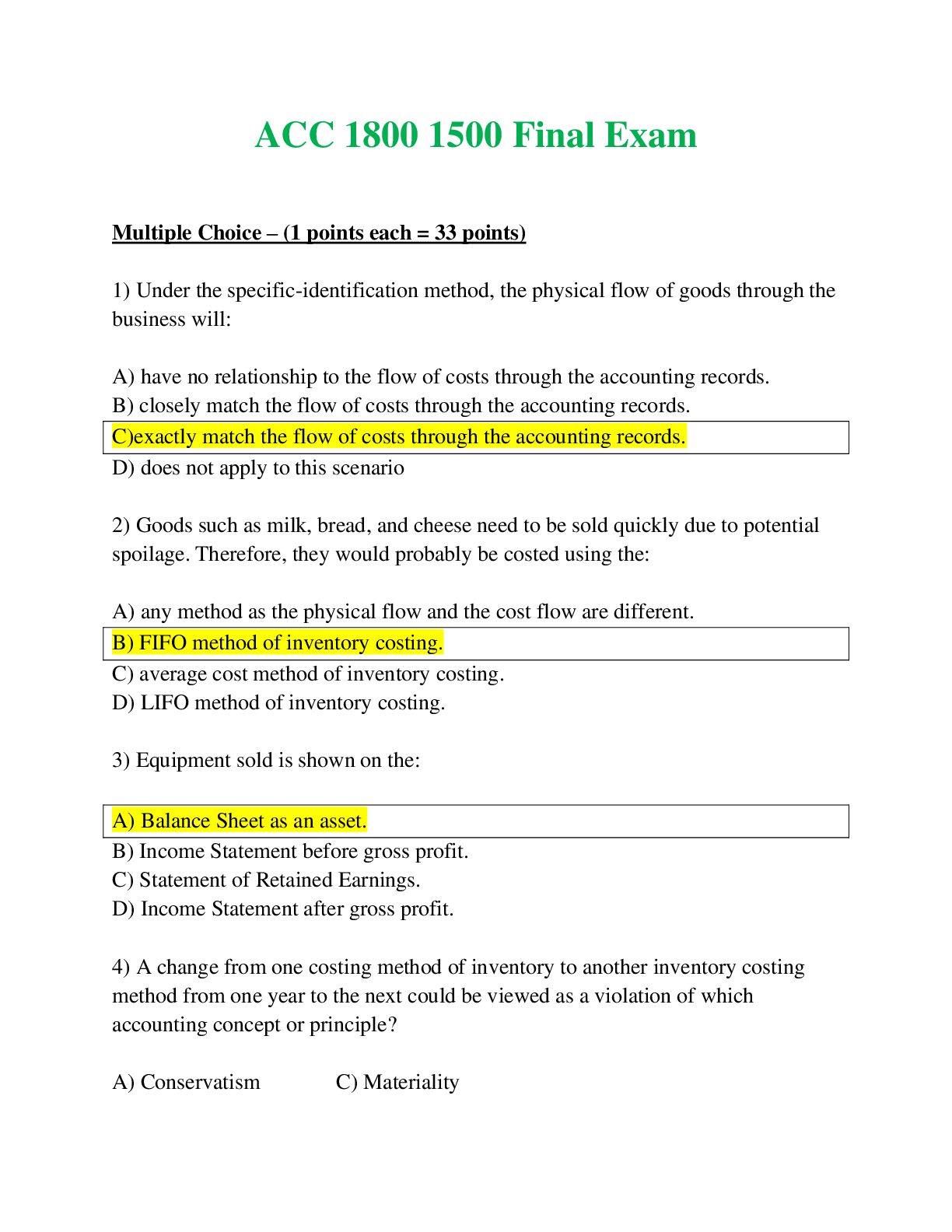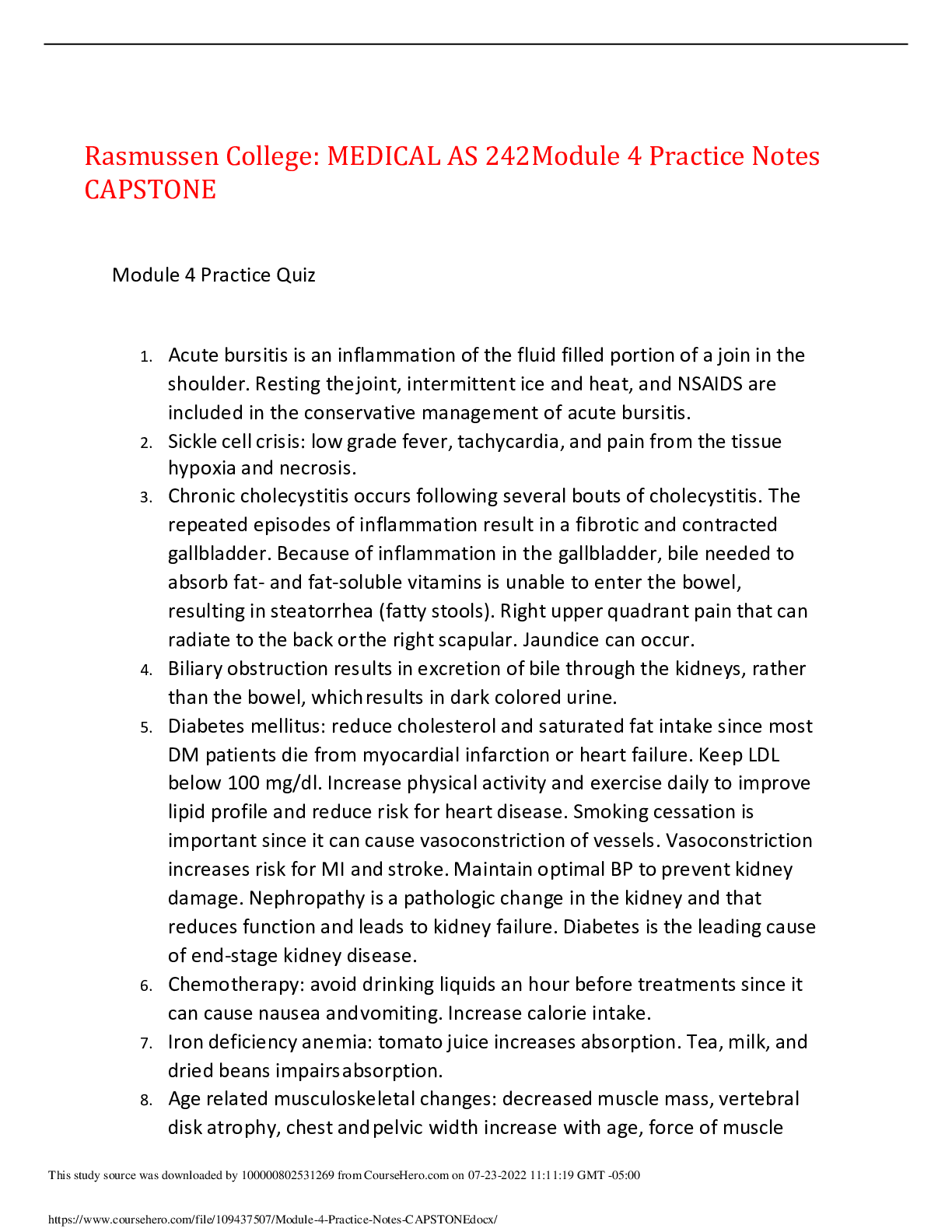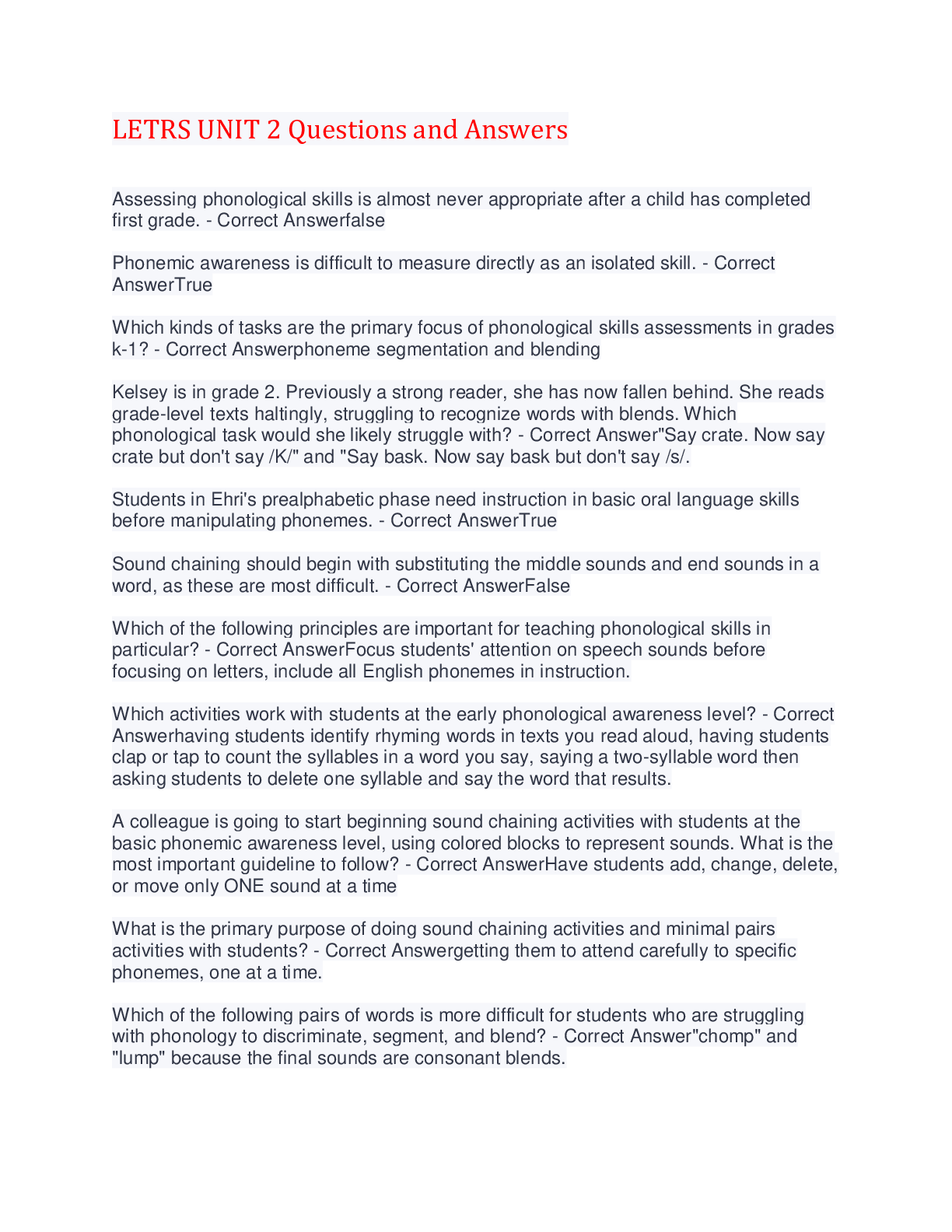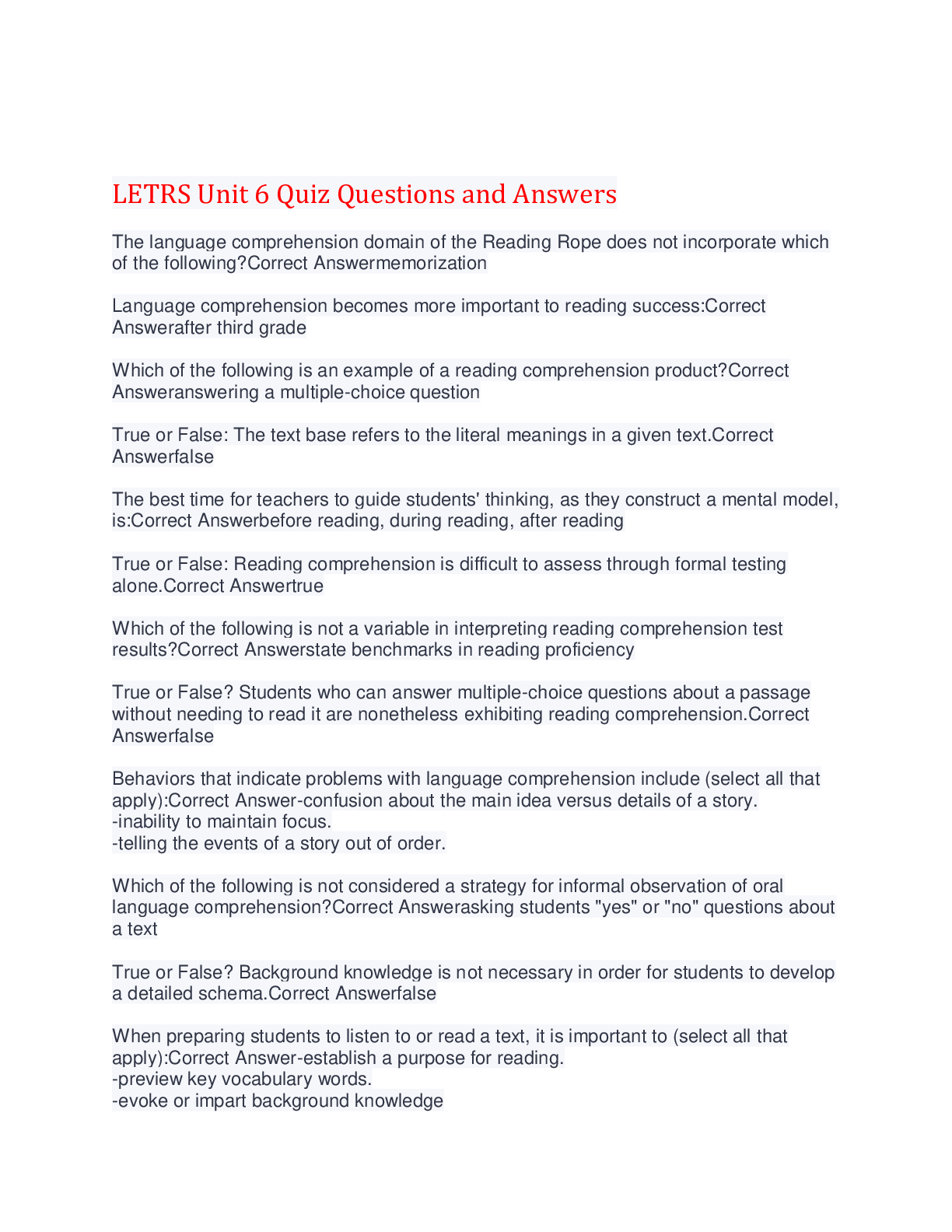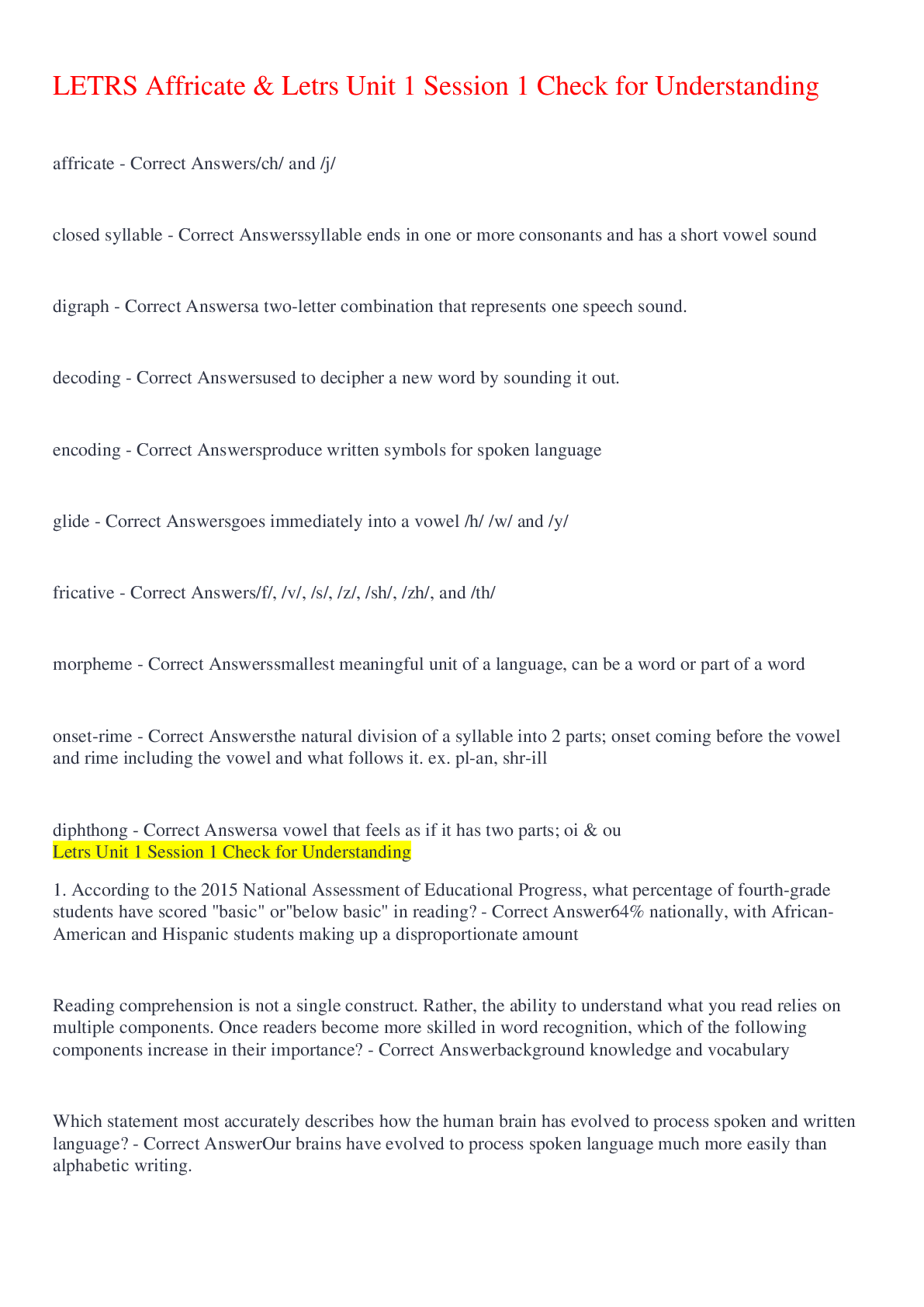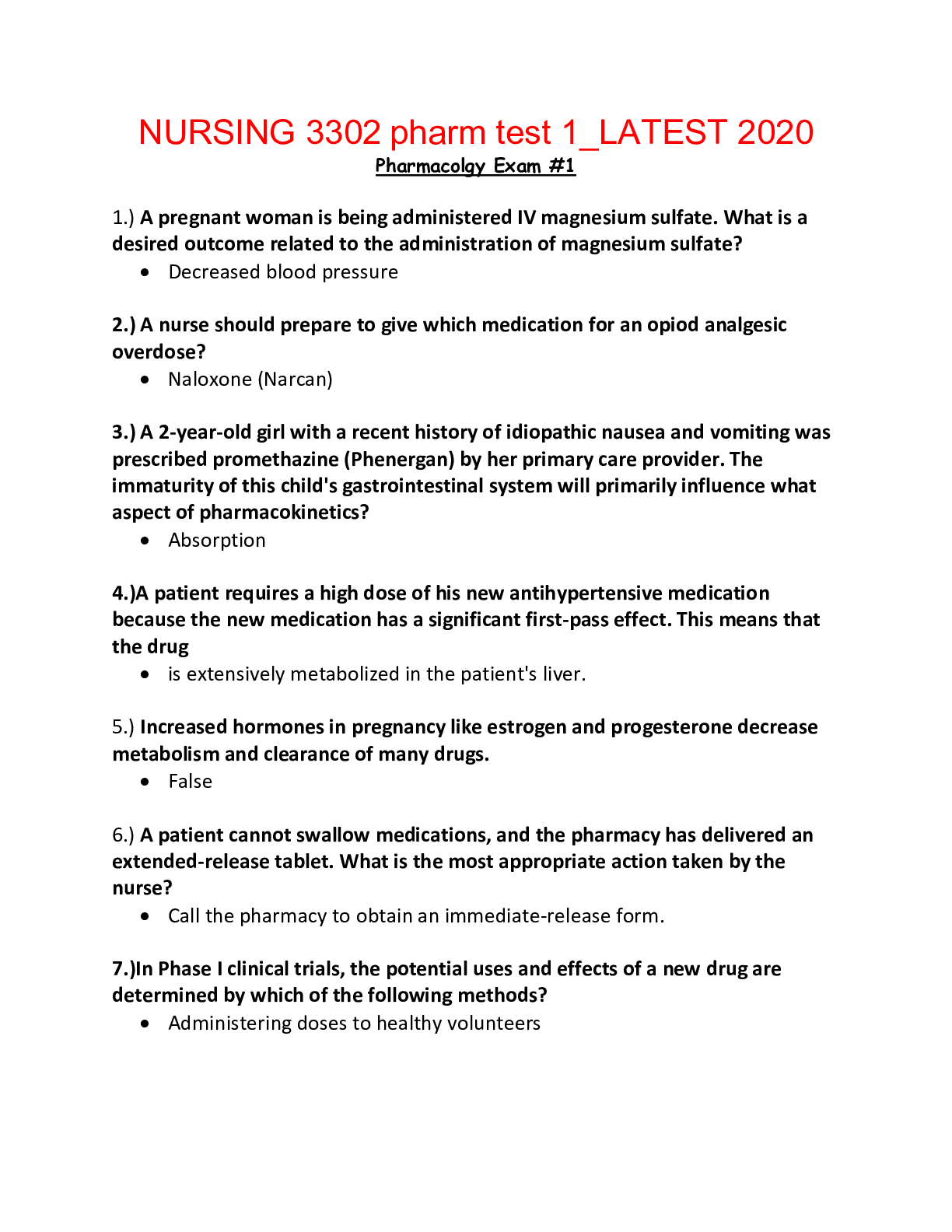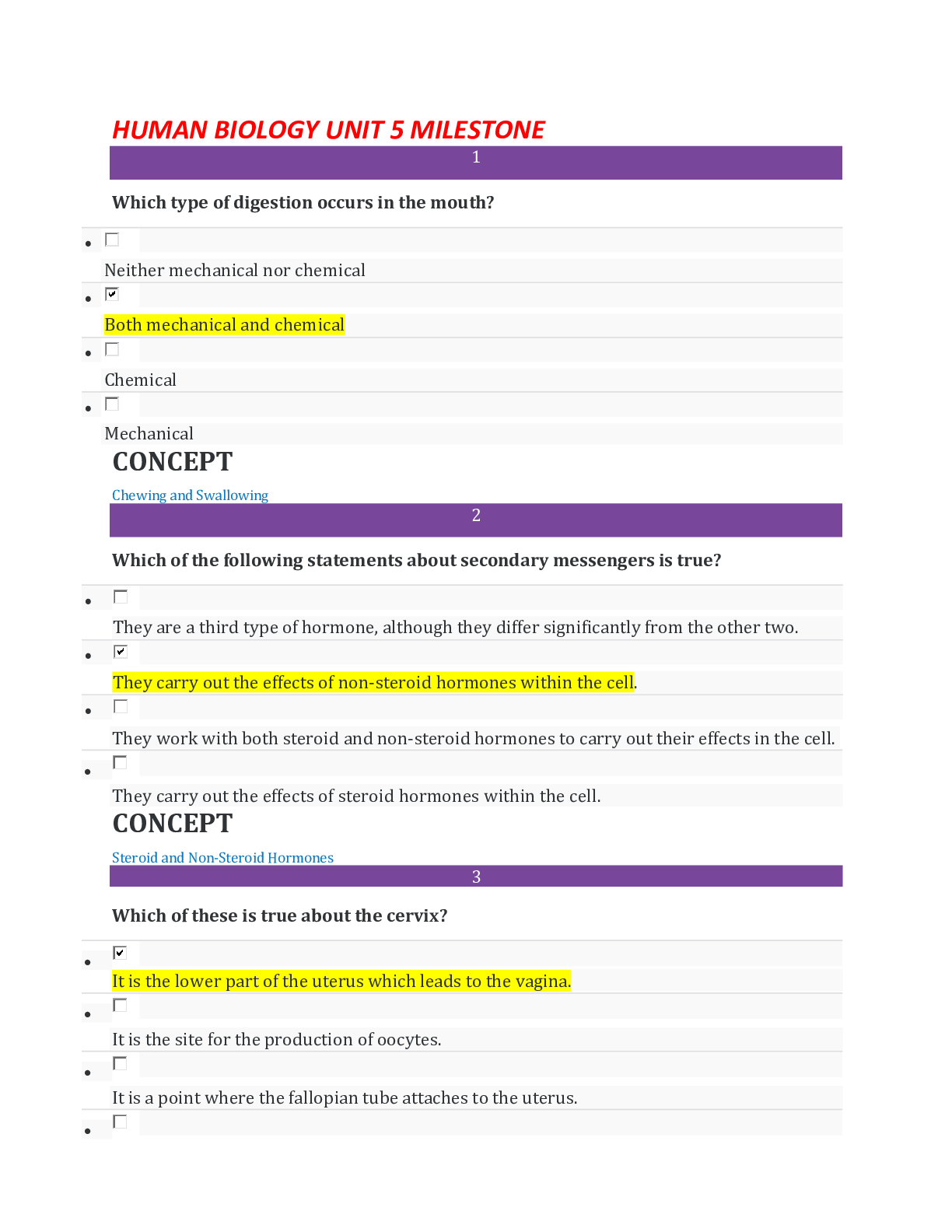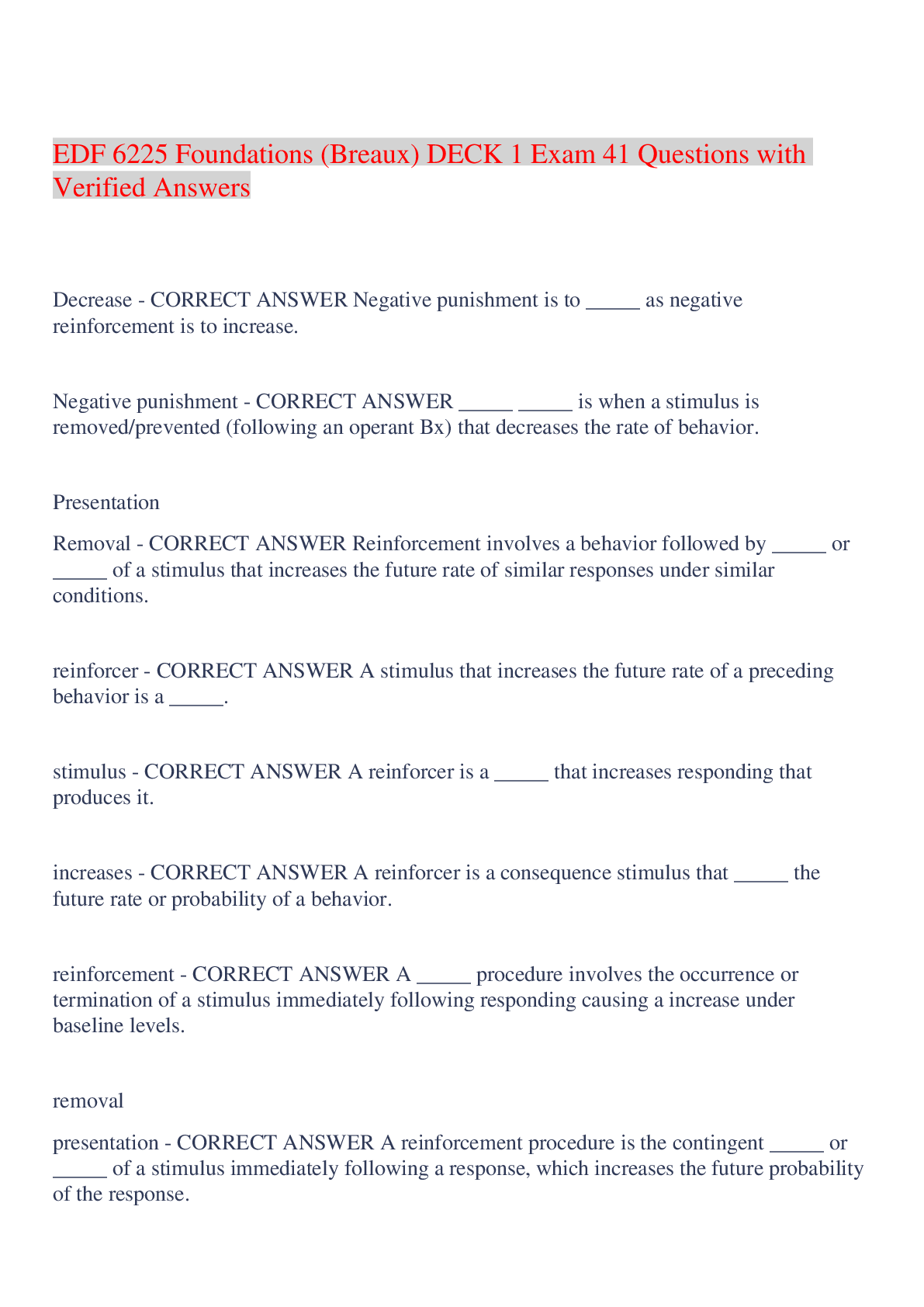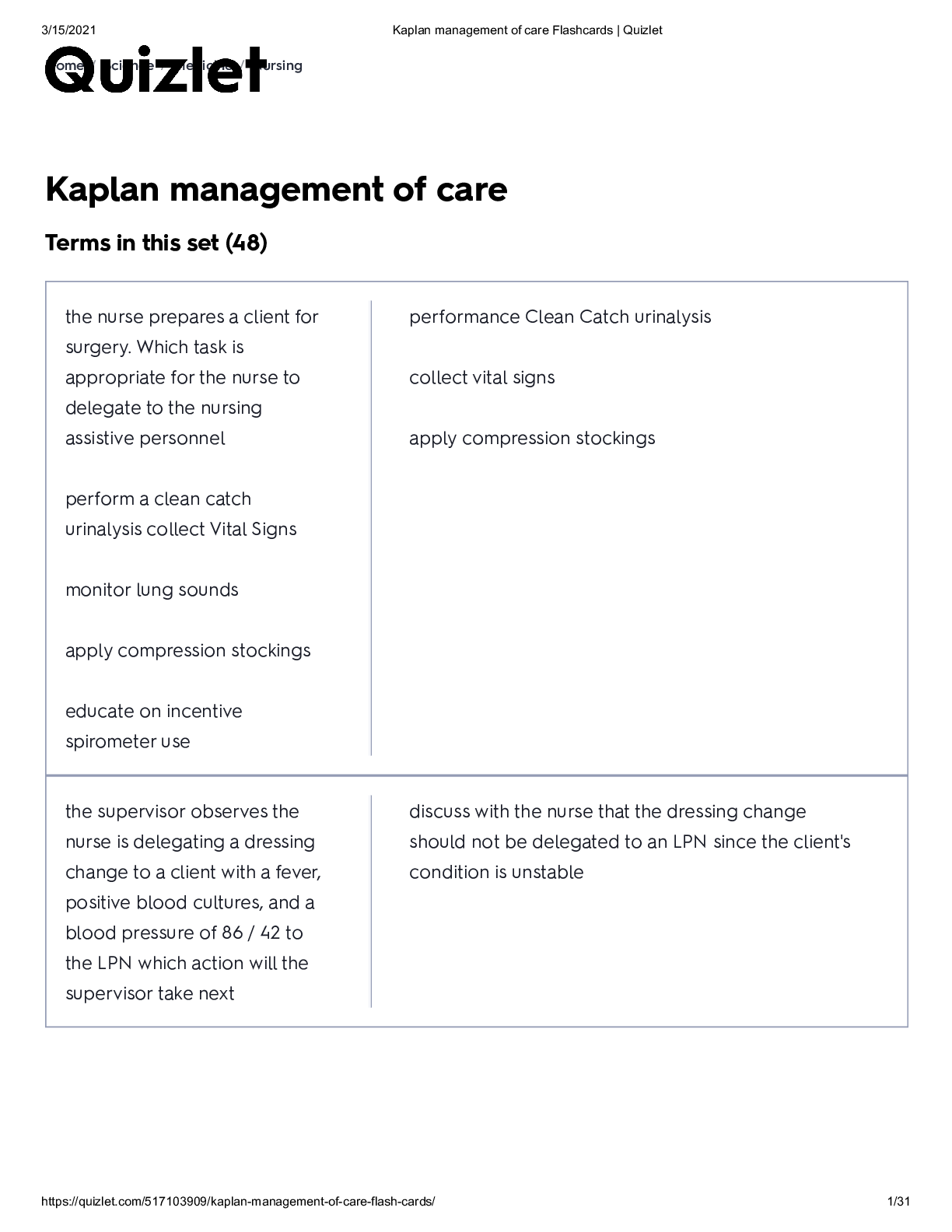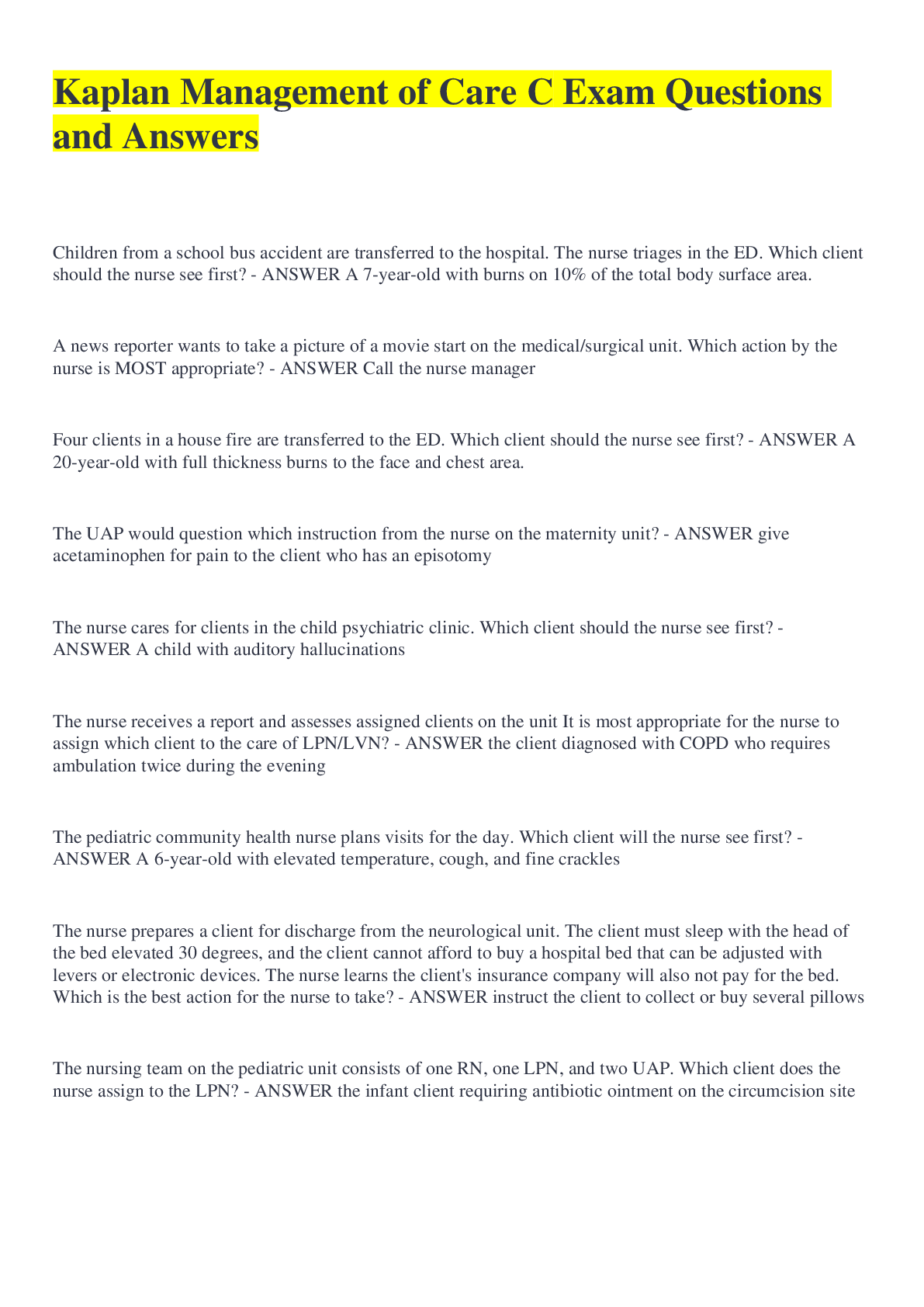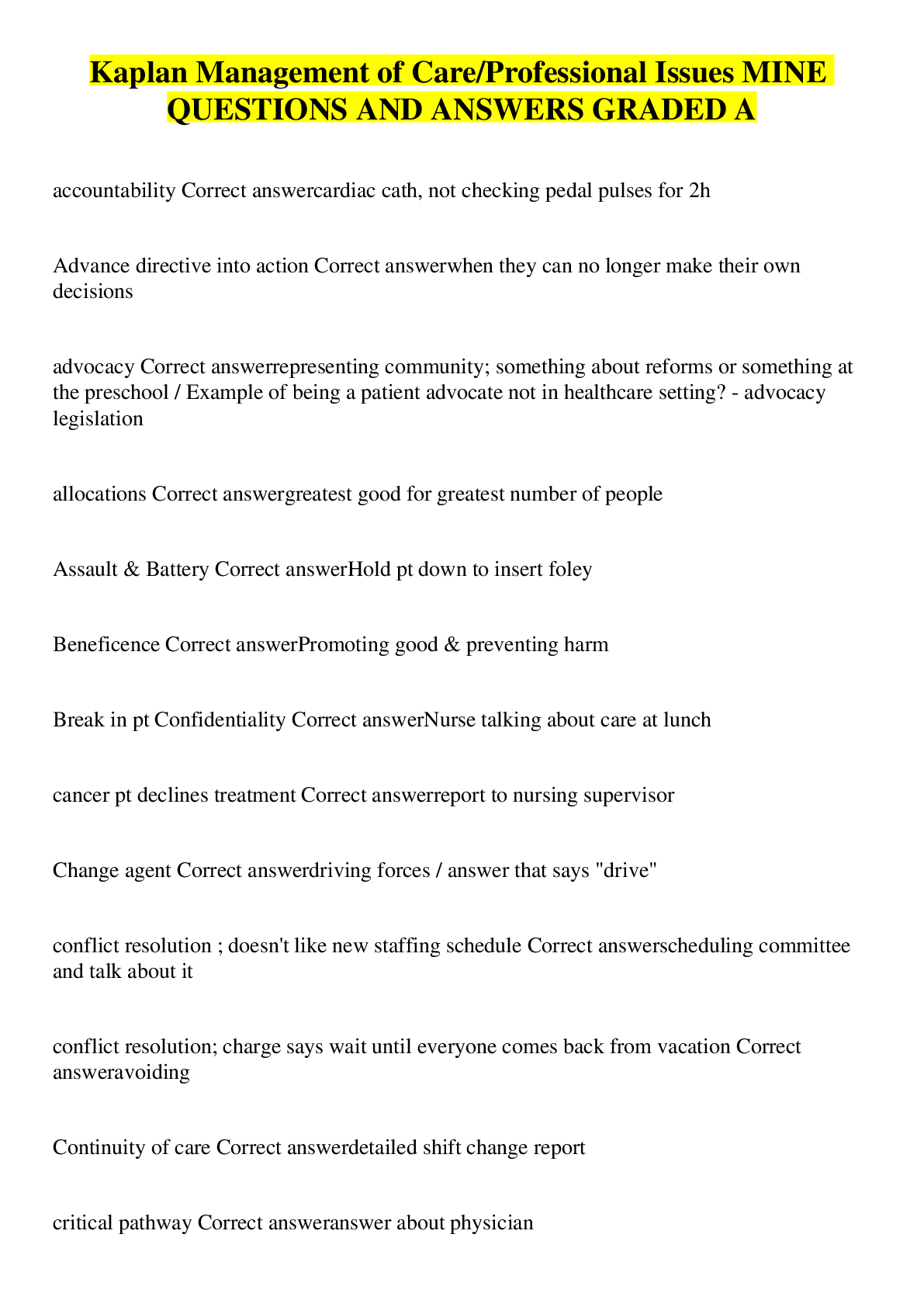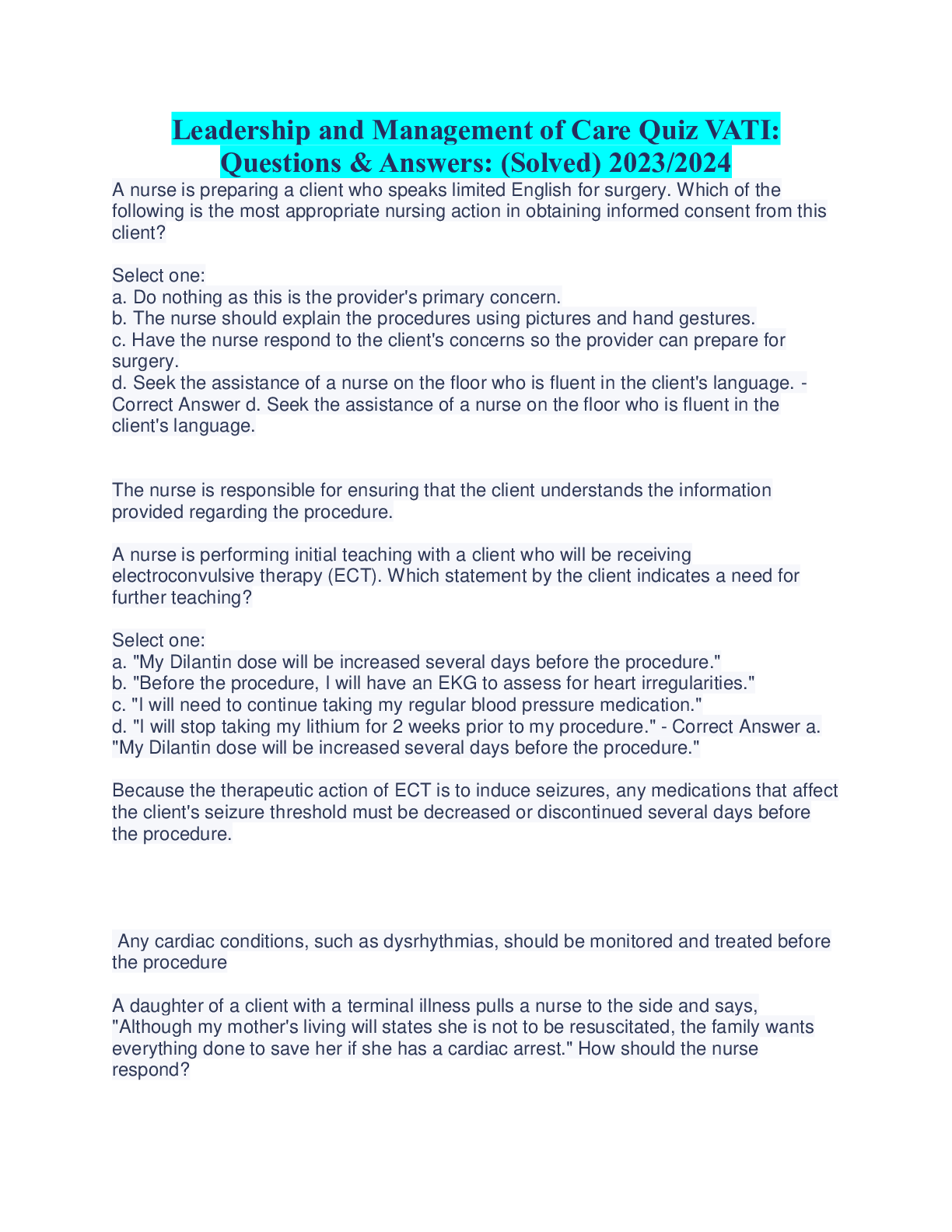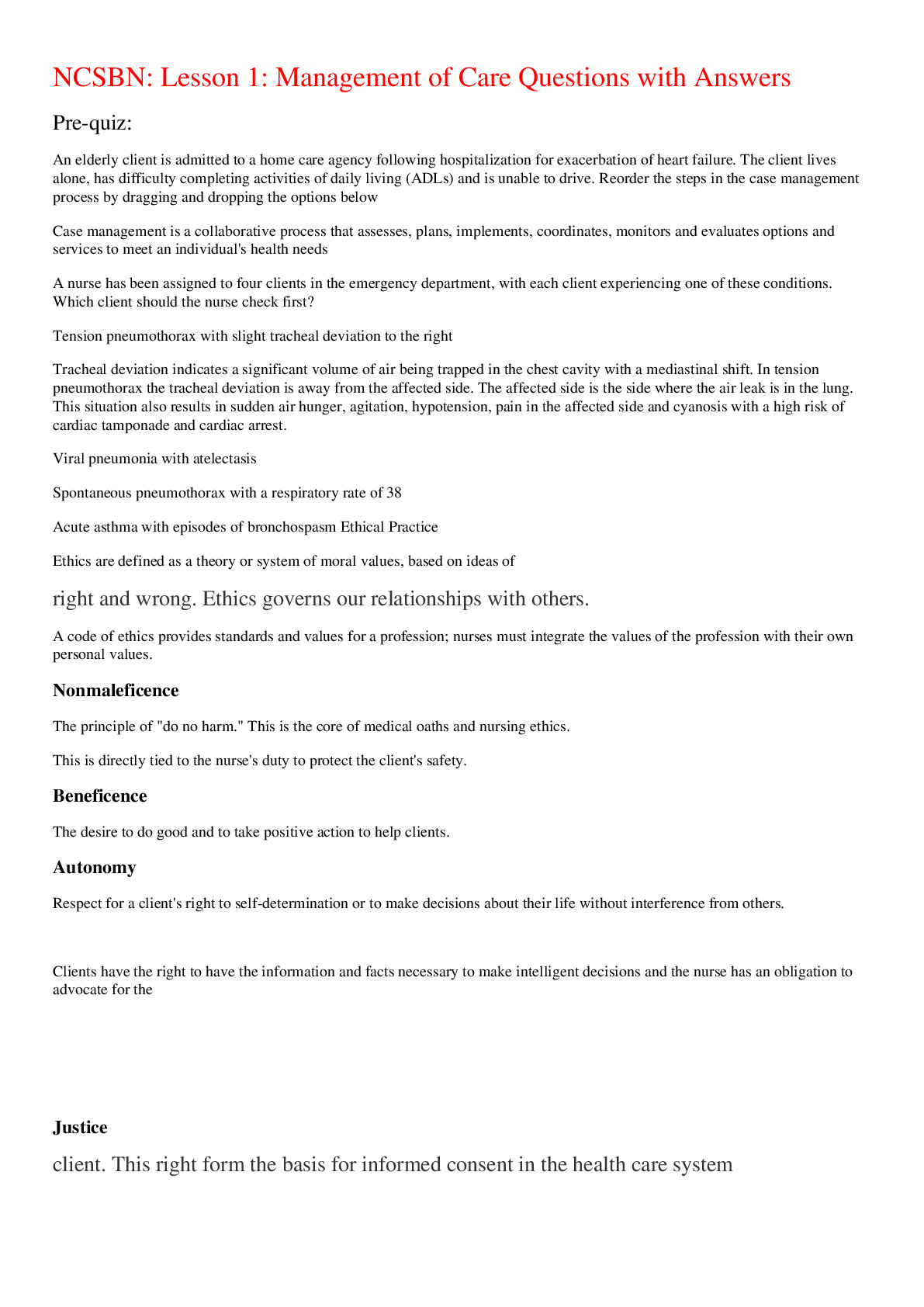*NURSING > EXAM > NR 222/ATI Remediation RN Leadership Management of Care Advocacy 2019,100% CORRECT (All)
NR 222/ATI Remediation RN Leadership Management of Care Advocacy 2019,100% CORRECT
Document Content and Description Below
NR 222/ATI Remediation RN Leadership Management of Care Advocacy 2019 Management of Care Advocacy 1. Professional Responsibilities: Caring for an Older Adult Client Who Might Be Abused (RM Leader... ship 8.0 Chp 3 Professional Responsibilities) ActiveLearningTemplate: Basic Concept Reasons for not reporting: - may be embarrassed or ashamed of abuse - worry about how their report may affect lives of loved ones - feel guilty and have come to believe they're cause of abuse - afraid no one will believe them - afraid of unknown future if they're removed from care of abuser - worst nightmare is to end in a nursing home Assessment for abuse: - examine client alone - don't rush during interview - don't be judgmental or allow personal feelings to interfere - don't diagnose prematurely Subjective data: - ask client to describe a typical day to determine degree if independence - ask client role and expectations for self and caregiver - inquire any recent family crisis - ask if there is any alcohol, drug use, mental illnesses in home Objective Data: - assess if patient senses being ignored or is made to feel like burden - assess degree of dependence of caregiver (financial, physical, and/or emotional support) - observe and document any new lesions Assignment, delegation and supervision 2. Managing Client Care: Assigning Client Care to a Licensed Practical Nurse (RM Leadership 8.0 Chp 1 Managing Client Care) ActiveLearningTemplate: Basic Concept • Monitoring client findings (as input to the RN’s ongoing assessment of the client) › • Reinforcement of client teaching from a standard care plan › • Tracheostomy care › • Suctioning › • Checking nasogastric tube patency • Administration of enteral feedings • Insertion of a urinary catheter • Medication administration (excluding intravenous medications in several states) 3. Managing Client Care: Feeding a Client Who Has Dysphagia (RM Leadership 8.0 Chp 1 Managing Client Care) ActiveLearningTemplate: Basic Concept • place client in an upright or high Fowler's position to facilitate swallowing • stay with client due to risk for aspiration • refer to speech therapist for evaluation • make diet alterations, avoid thin liquids and sticky foods 4. Managing Client Care: Nursing Assessment to Perform Prior to Delegation of Care (RM Leadership 8.0 Chp 1 Managing Client Care) ActiveLearningTemplate: Basic Concept Case Management 5. Coordinating Client Care: Addressing Priority Issues During Case Management (RM Leadership 8.0 Chp 2 Coordinating Client Care) ActiveLearningTemplate: Basic Concept • Open communication: Use “I” statements, and remember to focus on the problem, not on personal differences. Listen carefully to what the other people are saying. Move a conflict that is escalating to a private location or postpone the discussion • Share ground rules with participants. For example, everyone is to be treated with respect, only one person can speak at a time, and everyone should have a chance to speak. • Steps of the problem-solving process • identify the problem • Discuss possible solutions • Analyze identified solutions – The potential pros and cons of each possible solution should be discussed • Select a solution. • Evaluate the solution’s ability to resolve the original problem. The outcomes surrounding the new solution should be evaluated according to the predetermined time line. The solution should be given adequate time to become established as a new routine before it is evaluated. If the solution is deemed unsuccessful, the problem-solving process will need to be reinstituted and the problem discussed again. • negotiation Client Rights 6. Professional Responsibilities: Inappropriate Use of Restraints (RM Leadership 8.0 Chp 3 Professional Responsibilities) ActiveLearningTemplate: Basic Concept • Prevents harm of self or others • Never used for: - Convenience of the staff - Punishment for the client - Clients who are extremely physically or mentally unstable - Clients who cannot tolerate the decreased stimulation of a seclusion room 7. Professional Responsibilities: Treatment Decisions (RM Leadership 8.0 Chp 3 Professional Responsibilities) ActiveLearningTemplate: Basic Concept • Competent adults have the right to refuse treatment, including the right to leave a health care facility without a discharge order from the provider. • If the client refuses a treatment or procedure, the client is asked to sign a document indicating that he understands the risk involved with refusing the treatment or procedure, and that he has chosen to refuse it. Advance Directives/Self-determination/Life planning 8. Professional Responsibilities: Client Advocacy Regarding Advance Directives (RM Leadership 8.0 Chp 3 Professional Responsibilities) ActiveLearningTemplate: Basic Concept • Providing written information regarding advance directives • Documenting the client’s advance directives status • Ensuring that advance directives are current and reflective of the client’s current decisions • Recognizing that the client’s choice takes priority when there is a conflict between the client and family, or between the client and the provider • Informing all members of the health care team of the client’s advance directives Collaboration with interdisciplinary team 9. Assessment of Fetal Well-Being: Interdisciplinary Care Conference (RM MN RN Chp 6 Assessment of Fetal Well- Being) ActiveLearningTemplate: Basic Concept • The nonstress test (NST) is a noninvasive antepartum evaluation of fetal well- being. • Fetal movement and fetal heart rate accelerations correlate with adequate oxygenation. • Normal function of the autonomic nervous system and adequate oxygenation is observed in a fetus through reactivity of the fetal heart rate. Confidentiality/information security 10. Professional Responsibilities: Priority Action for a Breach of Electronic Health Information (RM Leadership 8.0 Chp 3 Professional Responsibilities) ActiveLearningTemplate: Basic Concept • The Privacy Rule of HIPAA requires that nurses protect all written and verbal communication about clients • Only health care team members directly responsible for the client's care are allowed access to the client's records • Clients have a right to read and obtain a copy of their medical record 11. Professional Responsibilities: Teaching About Client Confidentiality (RM Leadership 8.0 Chp 3 Professional Responsibilities) ActiveLearningTemplate: Basic Concept • Clients have the right to privacy and confidentiality in relation to their health care information and medical recommendations. • Nurses who disclose client information to an unauthorized person can be liable for invasion of privacy, defamation, or slander. • The security and privacy rules of HIPAA were enacted to protect the confidentiality of health care information and to give the client the right to control the release of information. Specific rights provided by the legislation include the following: • The rights of clients to obtain a copy of their medical record and to submit requests to amend erroneous or incomplete information • A requirement for health care and insurance providers to provide written information about how medical information is used and how it is shared with other entities (permission must be obtained before information is shared) • The rights of clients to privacy and confidentiality nurse role in confidentiality - EMR password protected and codes are not to be shared with other health care workers - discuss client information in private locations and only with those pt has agreed upon - use screen savers to protect pt information - place written reports/records in protected area - no part of pt chart can be copied (only when authorized-->transfers) - understand and apply facility policies for accessing pt cahrts - bedside report Continuity of care 12. Professional Responsibilities: Managing a Client's Personal Items (RM Leadership Chp 3 Professional Responsibilities) ActiveLearningTemplate: Basic Concept • The patient will need to remove valuables such as jewelry, dentures, glasses and prosthetics before surgery. • The first option for the patient's valuables is to leave them with family while they are in surgery. • The other option for the patient's valuables is to have the nurse safely store them before surgery. Information Technology 13. Coordinating Client Care: Objectives of Telehealth (RM Leadership 8.0 Chp 2 Coordinating Client Care) ActiveLearningTemplate: Basic Concept Telehealth: A wide range of health services delivered by telecommunications ready tools, such as videophone, telephone, and computer. Objective: - Brings care to patient - add choices - increase satisfaction - decrease disparities - increase healthcare provider availability - increase quality of care decrease cost (shift) Legal Rights and Responsibilities 14. Epidemiology and Communicable Diseases: Reportable Infectious Diseases (RM CH RN 8.0 Chp 3 Epidemiology and Communicable Disease) ActiveLearningTemplate: Basic Concept • Ensure appropriate medical treatment of diseases (tuberculosis). • Monitor for common-source outbreaks (foodborne: hepatitis A) • Plan and evaluate control and prevention plans (immunizations for preventable diseases) • Identify outbreaks and epidemics • Determine public health priorities based on trends • Educate the community on prevention and treatment of these diseases Reportable diseases - AIDS - Anthrax - Botulism - Cholera - Diphtheria - Encephalitis - Giardiasis - Gonorrhea - Hepatitis A-D - Influenza activity - Legionellosis/Legionnaires' disease - Leprosy - Lyme disease - Malaria - Meningococcal infections - Mumps - Pertussis - Poliomyelitis - Rabies - Rocky Mountain spotted fever - Rubella - Rubeola (measles) - Salmonellosis - Shigellosis - Syphilis - Smallpox - Tetanus - Toxic shock syndrome - Trichinosis - Tuberculosis - Typhoid fever - Vancomycin-resistant Staphylococcus aureus (VRSA) - Varicella (chickenpox) Ethical Practice 15. Professional Responsibilities: Making Decisions for End-of-Life Care (RM Leadership 8.0 Chp 3 Professional Responsibilities) ActiveLearningTemplate: System Disorder • Advance directives communicate a client's wishes regarding end-of-life care should the client become unable to do so • A durable power of attorney for health care, as an adjunct to a living will, can be a more effective way of ensuring that the client's decisions about health care are honored • Recognize that the client's choice takes priority when there is a conflict between the client and family, or between the client and the provider Performance Improvement (quality improvement) 16. Maintaining a Safe Environment: Strategies for Cost Containment (RM Leadership Chp 4 Maintaining a Safe Environment) ActiveLearningTemplate: Basic Concept • Strategies that promote efficient and competent client care while also producing needed revenues for the continued productivity of the organization • Strategies that achieve optimal results in relation to the money spent to achieve those results. • Providing clients with needed education to decrease or eliminate future medical costs associated with future complications 17. Managing Client Care: Performance Improvement Process (RM Leadership 8.0 Chp 1 Managing Client Care) ActiveLearningTemplate: Basic Concept • A standard is developed and approved by facility committee. • Standards are made available to employees by way of policies and procedures. • Quality issues are identified by staff, management, or risk management department. • An interprofessional team is developed to review the issue. • The current state of structure and process related to the issue is analyzed - Data should be collected over time. - observed behavior should be documented/used as evidence of satisfactory or unsatisfactory performance. - Peer review should Focus on the peer’s performance in relation to the job description or an appraisal tool that is based on institutional standards. Be shared with the peer and usually the manager. The employee should be given the opportunity to provide input into the evaluation 18. Managing Client Care: Using a Quality Improvement Method (RM Leadership 8.0 Chp 1 Managing Client Care) ActiveLearningTemplate: Basic Concept • Outcome clinical indicators- reflect desired client outcomes related to the standard under review. • Structure indicators- reflect the setting in which care is provided and the available human and material resources. • Process indicators- reflect how client care is provided and are established by policies and procedures (clinical practice guidelines). • Benchmarks- are goals that are set to determine at what level the outcome indicators should be met. 19. Professional Responsibilities: Incident Reporting (RM Leadership 8.0 Chp 3 Professional Responsibilities) ActiveLearningTemplate: Basic Concept • Incident reports should be completed as soon as possible and within 24 hr of the incident; • Incident reports are are not shared with client, nor is it acknowledged to client that one was completed; • Incident reports not placed nor mentioned in client's health care record [However, a description of the incident itself should be documented factually in client's record]; • nclude an objective description of incident and actions taken to safeguard client, and assessment and treatment of any injuries sustained; • Incident reposrts are forwarded to the risk mgmt department, possibly after being reviewed by the nurse manager Included in an incident report: • Client's name and hospital number, and date, time, and location of incident; • Factual description of incident and injuries incurred -avoid assumptions as to cause of incident; • Names of any witnesses to incident and any client or witness comments regarding incident; • Corrective actions that were taken, including notification of HCP and any referrals; • Name and dose of any meds or ID number of any equipment involved in incident Establishing Priorities 20. Managing Client Care: Prioritizing Care for Four Clients (RM Leadership 8.0 Chp 1 Managing Client Care) ActiveLearningTemplate: Basic Concept • Prioritize systemic before local (“life before limb”). • Prioritize acute (less opportunity for physical adaptation) before chronic (greater opportunity for physical adaptation). • Prioritize actual problems before potential future problems • Listen carefully to clients and don’t assume. • Recognize and respond to trends versus transient findings. • Recognize signs of medical emergencies and complications versus “expected client findings.” • Apply clinical knowledge to procedural standards to determine the priority action. Determining Client Care Priorities: • A client who has an acute problem takes priority over a client who has a chronic problem. • A client who has an urgent need takes priority over a client who has a nonurgent need. • A client who has unstable findings takes priority over a client who has stable findings. Safety and Infection Control Accident/Error/Injury Prevention 21. Maintaining a Safe Environment: Action to Take for a Client Who Is Yelling Obscenities (RM Leadership 8.0 Chp 4 Maintaining a Safe Environment) ActiveLearningTemplate: Basic Concept Assessment of anger: - Frowning - Clenched fists - Low-pitched words forced through clenched teeth - Yelling & shouting - Intense or no eye contact - Easily offended - Defensive - Passive-aggressive - Emotional overcontrol & flushed face - Intense discomfort - Tension Assessment of aggressor - Pacing - Restlessness - Tense face & body - Verbal or physical threats - Loud voice, shouting, use of obscenities - Argumentative - Increased agitation - Threats of SI/HI - Overreaction to environmental stimuli - Panic anxiety, leading to misinterpretation of the environment - Disturbed thought processes - Suspiciousness - Disproportionate anger Prevention is the key issue in the management of aggressive or violent behavior (1st priority) Three factors are important considerations in identifying extent of risks - Past history of violence - Patient diagnosis - Current behavior Diagnosis/Outcome Identification: Nursing diagnoses for inappropriate expression of anger or for aggressive behavior include - Complicated grieving (if anger is related to a loss) - Ineffective coping - Risk for self-directed or other-directed violence Planning/Implementation r/t Anger & Aggression: - Remain calm and in control - Early identification & intervention! - Ignore initial derogatory remarks - Maintain therapeutic relationship & deescalate (Validate concerns/frustrations/Summarizing, Restating, Verbalizing the Implied) (Assist to Express Feelings/SILENCE, Reflecting, Encouraging Description of Perceptions) - Set verbal limits on behavior (Give appropriate feedback/Avoid touching the patient) - Assist in Problem Solving (Help determine source of anger/Help find alternative ways of releasing tension) 22. Maintaining a Safe Environment: Preventing Falls (RM Leadership 8.0 Chp 4 Maintaining a Safe Environment) ActiveLearningTemplate: Basic Concept • Nurses should assess all clients admitted to healthcare facilities for risk factors related to Falls. Based on assessment findings the nurse should implement preventative measures. • plan for each client is individualized based on the fall risk assessment findings. • Be sure the client knows how to use the call light, that it is in reach, and encourage its use • Orient the client to the setting and ensure that the client understands how to use all assistive devices and can locate necessary items • Keep the bed rails up and the bed in the low position for clients who are sedated, unconscious, or otherwise compromised. • keep assistive devices (glasses, walkers, transfer devices) nearby after validation of safe use by the client and family • older adult clients can by at an increased risk for falls due to decreased strength, impaired mobility, and balance endurance limitations and decreased sensory perception • other risk factors include decreased visual acuity generalize weakness orthopedic problems (orthopedic problems) urinary frequency gait and balance problems (Parkinson's disease, osteoporosis, arthritis) and cognitive function. Adverse effects of medications (orthostatic hypotension, drowsiness) also can increase the risk for falls. • clients are at greater risk for falls on multiple risk factors are present. Emergency response plan 23. Facility Protocols: Client Triage During a Mass Casualty Incident (RM Leadership Chp 5 Facility Protocols) ActiveLearningTemplate: Basic Concept • Principles of mass casualty triage should be followed in health care institutions involved in a mass casualty event • These differ from the principles of triage typically followed during provision of day to day services in an emergency or urgent care setting • during mass casualty event, casualties are separated related to their potential for survival, and treatment is allocated accordingly. This type of triage is based on doing the greatest good for the greatest number of people. • Nurses find this situation very stressful because clients who are not expected to survive are cared for last Reporting of Incident/Event/Irregular Occurrence/Variance 24. Facility Protocols: Actions to Take When Completing an Incident Report (RM Leadership 8.0 Chp 5 Facility Protocols) ActiveLearningTemplate: Basic Concept • Incident reports are records of unexpected or unusual incidents that affected a client, employee, volunteer, or visitor in a health care facility • Facilities can also refer to incident reports as unusual occurrence or quality variance reports • In most states, as long as proper safeguards are employed, incident reports cannot be subpoenaed by clients or used as evidence in lawsuits Security plan 25. Facility Protocols: Triage Tagging (RM Leadership 8.0 Chp 5 Facility Protocols) ActiveLearningTemplate: Basic Concept • Emergent category (class I) – Highest priority is given to clients who have life- threatening injuries but also have a high possibility of survival once they are stabilized. • Urgent category (class II) – Second-highest priority is given to clients who have major injuries that are not yet life-threatening and usually can wait 45 to 60 min for treatment. • Nonurgent category (class III) – The next highest priority is given to clients who have minor injuries that are not life-threatening and do not need immediate attention. • Expectant category (class IV) – The lowest priority is given to clients who are not expected to live and will be allowed to die naturally. Comfort measures may be provided, but restorative care will not. Standard Precautions/Transmission-Based Precautions/Surgical Asepsis 26. Infection Control: Evaluating Assistive Personnel's Understanding of Precautions (RM Fund 10.0 Chp 11 Infection Control) ActiveLearningTemplate: Basic Concept Infection control is extremely important to prevent cross-contamination of communicable organism and health care-associated infections. • Staff education on infection prevention and control is a responsibility of the nurse. • Facility policies and procedures should serve as a resource for proper implementation of infection prevention and control. • Clients suspected of having or known to have a communicable disease should be placed in the appropriate form of isolation. • The nurse should ensure that appropriate equipment is available and that isolation procedures are properly carried out by all health care team members. • Use of standard precautions by all members of the health care team should be enforced. Employees who are allergic to latex should have non-latex gloves (nitrile or vinyl) made available to them. A latex-free environment is provided for clients who have a latex allergy. Many facilities avoid the use allergy. Many facilities avoid the use of latex products unless there is no other alternative. • Facilities should provide resources for employees to perform hand hygiene in client care areas. • Four levels of precautions (standard, aiborne, droplet, contact) are recommended for individuals coming in contact with clients carrying infectious organisms. Precautions consistent with the infectious organism should be followed as indicated [Show More]
Last updated: 2 years ago
Preview 1 out of 24 pages
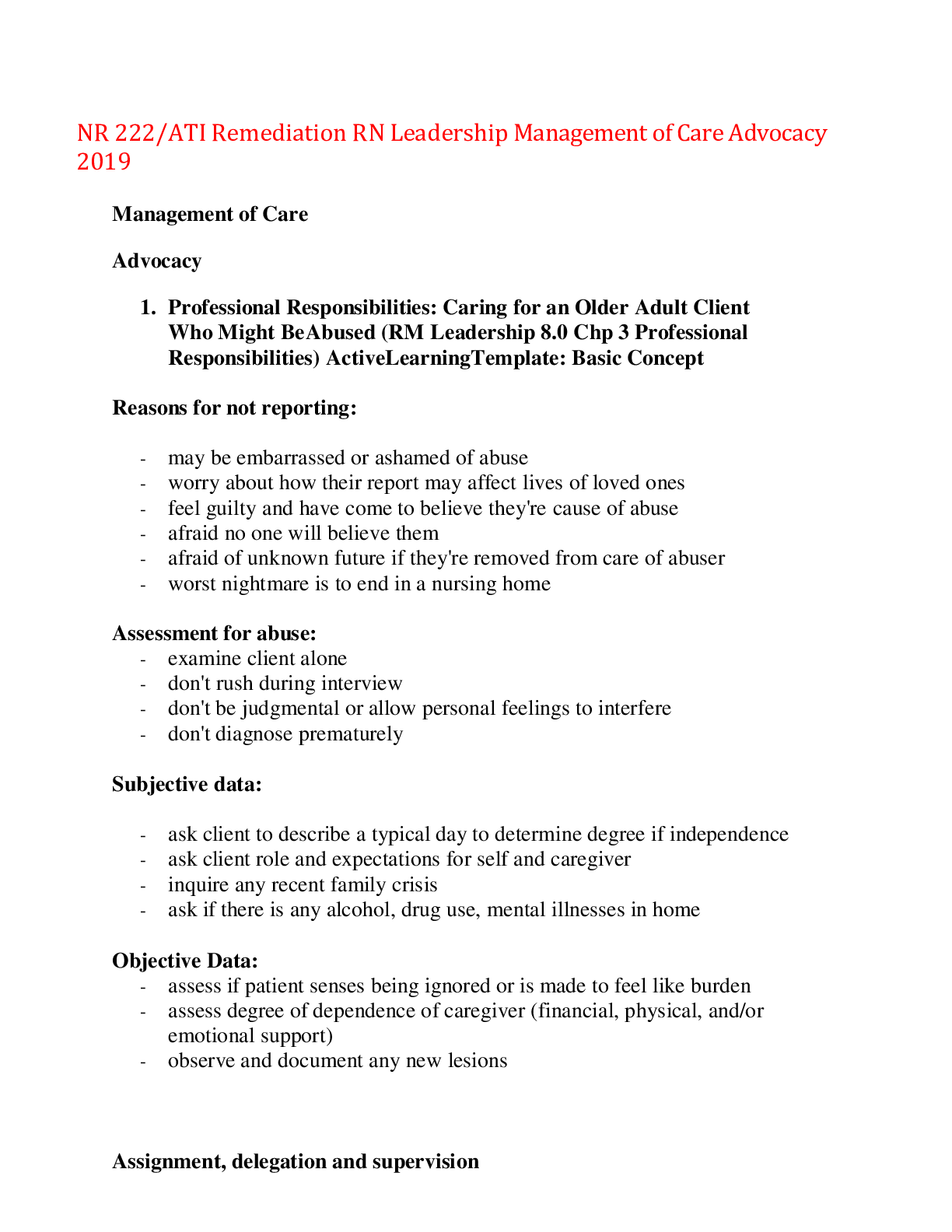
Buy this document to get the full access instantly
Instant Download Access after purchase
Buy NowInstant download
We Accept:

Reviews( 0 )
$14.00
Can't find what you want? Try our AI powered Search
Document information
Connected school, study & course
About the document
Uploaded On
Nov 29, 2022
Number of pages
24
Written in
Additional information
This document has been written for:
Uploaded
Nov 29, 2022
Downloads
0
Views
50


